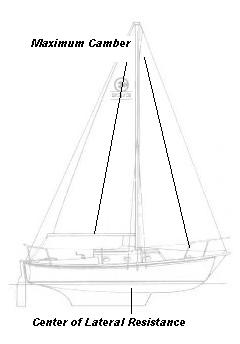
 Click Image For The Sailboat Company's Home Page
Click Image For The Sailboat Company's Home Page
Sailing 101
The fundamentals of sailing are simple. However, if someone doesn't tell you how it's done, it could be a mystery for a long period of time. The answer in one word is balance and our sailing balance is the diagram below. Everything that's dynamic like flying and sailing or even holding a baby appears to be difficult at first. Once you understand the psychics involved in any process, the process becomes less difficult and maybe even easy. I still can't get the hang of inline skates, but I think bent knees may be the secret.

The line marked "Center of Lateral Resistance" or CLR in the graphic above is a point that sailboats move around as they turn. In the real world of sailboats, half of the hull's wetted surface would be forward of this line and other half would be behind this line. If the boat was in the water and I pushed on the side of the boat towards the bow with both hands, the boat would pivot on the CLR. I would be moving the same amount of water on both sides of the boat, but in opposite directions. A car pivots on it's front wheels and a sailboat or any other boat pivots on its CLR. I'm sure we now understand the water dynamics of a sailboat's hull.
Keeping in mind that the essence of sailing and what we are trying to achieve is balancing our boat in all wind and sea conditions. Maintaining very little weather helm or a very light pressure on the tiller indicates your boat is balanced. Balancing means keeping the same amount of sail power on both sides of the CLR. Forcing an unbalanced boat to sail on a course with the rudder causes drag and makes a boat slow. You should try to avoid stopping the boat with the rudder while the sails are trying to propel the boat forward.
Sailmakers build sails to sail in very light wind and with adjustments from you, sail in heavy wind. All the power in sails are at the maximum camber point. This point changes its position with wind strength. You can look at the sails while you are sailing and see this point. It will be taut without wrinkles and on the same lines as the graphic above. Wrinkles will exist in front of and to the rear of the maximum camber point. As the wind blows harder, the maximum camber point blows or moves aft. We now have more sail power behind the CLR than we did before and we need to do something to rebalance our boat. As the power in the sails are blown aft, more rudder will be required to keep the boat on course. More rudder means more drag and that's a bad thing. If we stretch the leading edge of both sails, the maximum camber point will move forward and rebalance our boat. Most sailors should identify three points of luff stretch on their sails for three levels of wind speeds between 0 and 12 knots.
That's all there is to sailing fundamentals. It helps to have a boat that has enough mass and ballast for a beginner can see the wind and trim changes in slow motion.
The Sailboat Company
Richlands, NC 910-324-4005